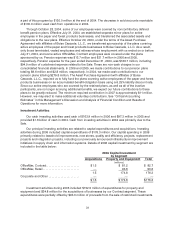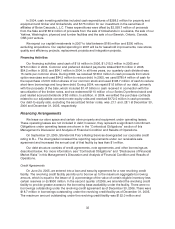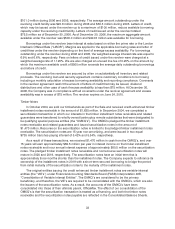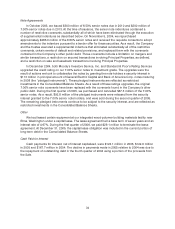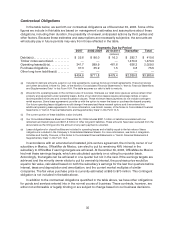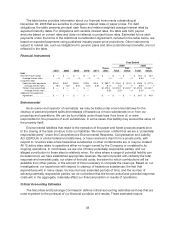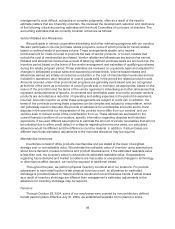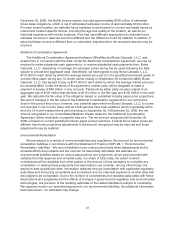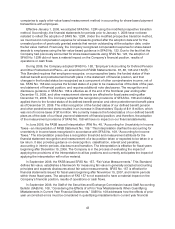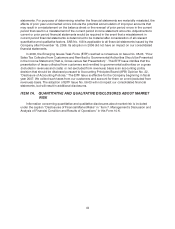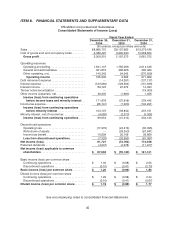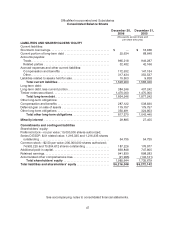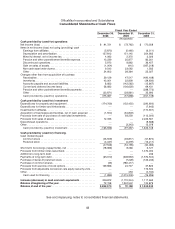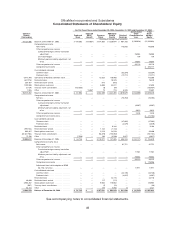OfficeMax 2006 Annual Report Download - page 43
Download and view the complete annual report
Please find page 43 of the 2006 OfficeMax annual report below. You can navigate through the pages in the report by either clicking on the pages listed below, or by using the keyword search tool below to find specific information within the annual report.39
management’s mostdifficult, subjective or complex judgments, often asaresult ofthe need to
estimate matters that are inherently uncertain. We reviewed the development, selection and disclosure
of the following critical accounting estimateswith the Audit Committee of our board of directors. The
accounting estimates that we currently consider critical are as follows:
Vendor Rebates and Allowances
We participate in various cooperative advertisingand other marketing programs with our vendors.
We also participate in volume purchase rebate programs, some ofwhich provide for tiered rebates
based on defined levels ofpurchase volume. These arrangements enable us to receive
reimbursement for costs incurred to promote the saleof vendor products, or to earn rebates that
reduce the cost of merchandise purchased. Vendor rebates and allowances are accrued as earned.
Rebates and allowances received as a result of attaining defined purchase levels are accrued over the
incentive period based onthe terms of the vendor arrangement and estimates of qualifying purchases
during therebate program period.These estimates are reviewed on a quarterly basis and adjusted for
changes in anticipated product sales and expected purchase levels. Volume-based rebates and
allowances earned are initially recorded as a reduction in the cost of merchandise inventories andare
included in operations (asa reduction of cost ofgoods sold) in the period the related product is sold.
Amounts received under other promotional programs are generally event-based and are recognized
at the time of the event as a reduction of cost of goods sold or inventory, as appropriate, based on the
natureof the promotion and the terms of the vendor agreement. Advertising and other allowances that
represent reimbursements ofspecific, incremental and identifiable costs incurred to promote vendors’
products are recorded as a reduction ofoperating and selling expenses inthe period the expense is
incurred. Amounts owed to us under these arrangements are subject to credit risk. In addition, the
terms of the contractscovering these programs canbe complex and subject to interpretation, which
can potentially result in disputes.Weprovide an allowance foruncollectible accounts and to cover
disputes in the event that our interpretation of thecontract terms differ from our vendors’ andour
vendors seek to recover some of the consideration from us.These allowancesare based on the
current financial condition of our vendors, specific information regarding disputes and historical
experience.If we used different assumptions toestimate the amount ofvendor receivables that will not
be collected due to either credit default or a dispute regarding theamounts owed, our calculated
allowance would be different and the difference could be material. In addition, ifactual lossesare
different thanthose estimated, adjustments to the recorded allowance may be required.
Merchandise Inventories
Inventories consist of office products merchandise and are stated at the lower of weighted
average cost or net realizable value. We estimate the realizable value of inventory using assumptions
about future demand, market conditions and product obsolescence. If the estimated realizable value
is less than cost, the inventory value is reduced to its estimated realizable value. If expectations
regarding future demand and market conditionsare inaccurate or unexpected changes in technology
or other factors affect demand, we could be exposed to additional losses.
Throughout theyear, we perform physicalinventory counts at all of our locations. For periods
subsequent to each retail location’s last physicalinventory count, an allowance for estimated
shrinkageis provided based on historical shrinkresults and current business trends. If actual losses
as a result of inventory shrinkage are different than management’s estimates, adjustments to the
allowance forinventory shrinkage maybe required.
Pensions
Through October 28, 2004, some ofour employees were covered by noncontributory defined
benefit pension plans. Effective July 31, 2004, we established separate mirror plansfor active




